
On Behalf of Others. Designed for English 11/12, modified for English 9.
- Subject:
- English Language Arts
- History
- Material Type:
- Unit of Study
- Date Added:
- 05/07/2015

On Behalf of Others. Designed for English 11/12, modified for English 9.
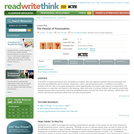
Using published writers' texts and students' own writing, this unit explores emotions that are associated with the artful and deliberate use of commas, semicolons, colons, and exclamation points (end-stop marks of punctuation).

In an eight week unit of study, students will explore concepts of migration through the lens of cultural identity and perspective. What are elements of culture that shape us, shape how we see others, and shape how we are seen in return? Students will investigate shifts in cultural norms and stereotypes specific to forced migration and captivity as depicted in The Tempest by William Shakespeare and supplemented through a variety of texts, discussions, and reflections.

In the first bend of this unit, students will closely read multiple perspectives on the “American Dream” in
order to collect information to use and integrate that information into an evidence-based perspective.
Students will examine primary and secondary source documents to make informed decisions about
what information to collect that may inspire their writing about “The American Dream.”
In the second bend of this unit, students will engage in a short-research process to create a draft of
argumentative speech on the “American Dream” with a specific purpose, audience, and tone in mind.
They will use their inquiry research questions from bend one to begin analyzing search results and citing
and gathering relevant, accurate, and credible information.
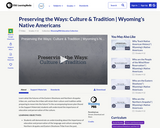
Learn what the futures of the Eastern Shoshone and Northern Arapaho tribes are, and how the tribes will retain their culture and tradition while preparing to move into the future? In the accompanying lesson plan (found in the Support Materials) students will understand the importance of education and perservation of the culture.
LEARNING OBJECTIVES:
Students will demonstrate an understanding about the importance of education and preservation of the language and culture among the Northern Arapaho and Eastern Shoshone Tribe from the past, present, and future.
Students will learn about the Federal Indian Policy to civilize Native Americans through the establishment of Native American Boarding Schools incorporating key vocabulary words.
Students will learn about how the practice of forced assimilation contributed to the diminished use of the Shoshone and Arapaho people’s lifestyle, languages, and traditions.
Students will discuss the development of Indian boarding schools in the United States and Wyoming.
Students will analyze the differences between the early educational experiences of the Native American and non-native students.
Students will examine the importance of education as a value that the Shoshone, Arapaho, and non-native communities share.
Students will consider how Native American students and non-native students can learn from each other to dispel the myths and stereotypes that exist in contemporary society.
Students will learn why oral traditions are important.
Students will understand why respect for elders is important in the tribe.
Students will gain an awareness of why traditional dancing and singing is important to traditions and culture.
Students will explore the significance of the buffalo to the Shoshone people living on the Wind River Reservation.
Students will learn that through traditional concepts of understanding, the Shoshone people, as well as many other Plains tribes, were able to survive through their sustenance on the buffalo.
Students will discuss the relationship that Native American people have with the buffalo (i.e., spiritual, sustenance, etc.) and how oral traditions play a critical role in the preservation of Native ways of knowing.
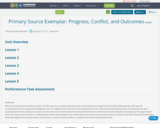
This unit is centered around an anchor text that may be common among content area teachers in a high school setting. Although this unit may be incorporated into any high-school English class, it is aligned with Common Core standards for 9-10. This unit will primarily focus on informational and argumentative texts, and can be used to incorporate more informational texts (as directed by the Common Core) into English classrooms at the high school level. This unit is best suited to a collaborative model of development in which ELA and content area teachers share an anchor text (The Universal Declaration of Human Rights) and communicate about how to connect diverse skills to common texts and essential questions.
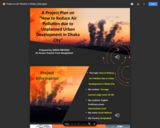
This project focuses on Air Pollution due to unplanned urban development in Dhaka City, Bangladesh, and how to reduce it

Context: The course focuses on pronunciation reading informational text, which determines the meaning of words and phrases as they are used in the text for learners, the importance of listen and speaking, these are good communication skills to learn the English language.
Relevance: This lesson will help prepare learners to effectively communicate and through education improve their lives. Knowing English increases your chances of getting a good job, learners will be able to get their certificates for a GED, or citizenship. The coverage in this lesson will focus on the English vocabulary, which is an important aspect in communication without sufficient vocabulary learners cannot understand others or express their own ideas.
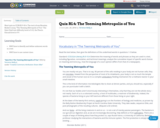
Short quiz on CCSS.RI.9-10.4. The text is from Brendan Buhler's essay, "The Teeming Metropolis of You". The Dale-Chall text-difficulty level is 11-12, the Flesch-Kincaid level is 9.9.

This 2 week lesson incorporates the CCSS ELA Standards using the Serial podcast, an engaging murder mystery podcast.
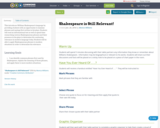
This introduces William Shakespeare's language by providing students with an opportunity to examine phrases and sayings first written in his plays. Students will read an informational text as well as spend time researching various Shakespearean phrases and their presence in his plays to determine his continuing relevance in modern language today. Students will be able to apply Shakespearean phrases to modern situations in order to determine his relevance.
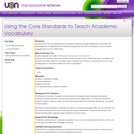
In this lesson students will use the core standards and an academic vocabulary template (adapted from Janet Allen and Robert Marzano) to explicitly learn the academic language they will need to understand, not only in English Language Arts, but in all content areas.
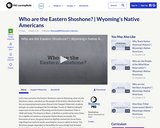
Learn how and when the Eastern Shoshone came to Wyoming, what are the Shoshone values, and what are the people of the Eastern Shoshone like? In the accompanying lessons plans (found in the Support Materials), students will gain an understanding of the Fort Bridger Treaty of 1868 including its importance to the state of Wyoming and the Eastern Shoshone Tribe in 1868 and today. The American Bison, or Buffalo as preferred by most tribes, has a significant existence among the Native American people. For thousands of years, the great American Buffalo roamed the Great Plains, migrating from north to south, searching for areas on which to thrive. The Shoshone people depended on the buffalo for many things that included food, clothing, and shelter. Every part of the buffalo was used and provided for the people.
LEARNING OBJECTIVES:
Students will study (Highlight, paraphrase and report) the Treaty of 1868 between the Eastern Shoshone Tribe and the United States Government.
Students will learn about the Eastern Shoshone people through the use of research and technology.
Students will understand that the history of the Shoshone people in the Wind River Mountains dates back thousands of years.
Students will understand that the circle of life continues in a perpetual cycle and is passed on through oral tradition. These stories often taught a lesson to young people.
Students will understand the indigenous perspective of interconnectedness. Students will understand how bison populations were devastated by western expansion.
Students will learn how to construct, read, compare and analyze different population graphs.
Students will understand how the diets of the Shoshone people varied depending on the areas in which they lived.
Students will acquire knowledge of the Wind River Reservation communities and be able to identify these locations on a map.
Students will be able to further describe how their culture has shaped them.
Students will be able to define the concept of culture.
Students will be able to explain some of the attributes of culture.
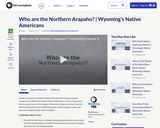
Students will gain an understanding of the Northern Arapaho people located on the Wind River Reservation in Wyoming. In the accompanying lessons plans (found in the Support Materials), students will learn how the Northern Arapaho come to Wyoming, what are the Arapaho values, and why were Arapaho tribal names changed?
LEARNING OBJECTIVES:
Students will be able to evaluate what geographical places were used by the Arapaho people and understand how historical events changed the future for the Arapaho people.
Students will compare and contrast between their social and ceremonial structures.
Students will understand the hierarchy of the Arapaho Tribe.
Students will analyze how their social and ceremonial structures contribute to their cultural identity.
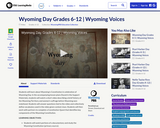
Students will learn about Wyoming's Constitution in celebration of Wyoming Day.